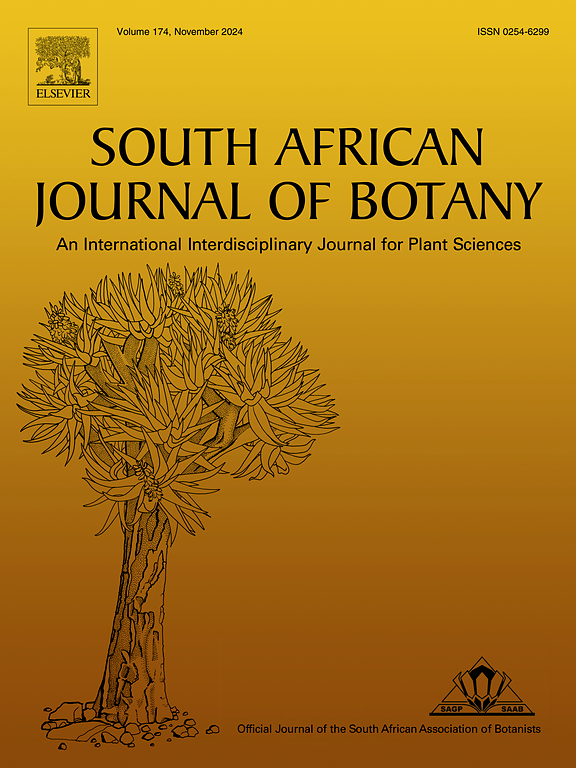不同盐度条件下叶面喷施甘氨酸甜菜碱和种子喷施甘氨酸甜菜碱对藜麦生理机能的不同影响
IF 2.7
3区 生物学
Q2 PLANT SCIENCES
引用次数: 0
摘要
不断上升的土壤盐度会损害植物,从而阻碍全球作物产量,威胁粮食安全。本研究评估了甘氨酸甜菜碱(GB)在藜麦上两季的施用方法(叶面喷施、种子打底)和盐度水平(0、60、120、180 mM NaCl)。就离子平衡而言,在低盐度条件下,种子底肥可将 K+/Na+ 比率提高 10-15%,而在高盐度条件下,叶面喷施的效果提高 12-18%。种子引种对根系的影响仍为 10-15 %。在低盐度条件下,叶面喷施可提高渗透溶质 12-16%,但在高盐度条件下,种子喷施的效果要强 16-20%。在低盐度条件下,种子底肥对叶绿素和光合作用效率的保护作用提高了 8-12%。在高盐度条件下,叶面喷施 GB 对叶绿素的保护效果好 10-15%,种子喷施对光合速率的保护效果好 12-16%,叶面喷施 GB 对 Fv/Fm 的保护效果好 8-10%。在低盐度条件下,GB 能使 MDA 减少 8-12%;在 2023 年的中等盐度条件下,种子诱导 GB 能使 MDA 减少 12-16%;在 2024 年,叶面喷施 GB 能使 MDA 减少 16-20%。在高盐度条件下,2023 年,种子引种可使 MDA 减少 20-25%,而叶面喷施则减少 24-28%。在轻度胁迫下,GB 能适度提高抗氧化剂 8-12 %,但在严重胁迫下,种子处理和叶面喷施的效果相差 16-20 %。养分方面,在 2023 年中等盐度条件下,种子催肥在氮素方面的优势为 12-16%,而在 2024 年高度胁迫条件下,叶面肥的优势为 16-20%。2023 年,在高盐度条件下,种子催肥对磷的效果提高了 16-20%,但在 2024 年,叶面肥的效果提高了 20-25%。这些发现凸显了植物对 GB 盐度相互作用的复杂反应,最佳方法因性状、胁迫水平和环境条件而异。本文章由计算机程序翻译,如有差异,请以英文原文为准。
Differential effects of foliar and seed priming glycine betaine application on quinoa physiology under varying salinity level
Rising soil salinity hinders global crop yields by damaging plants, threatening food security. This study assessed glycine betaine (GB) application methods (foliar, seed priming) and salinity levels (0, 60, 120, 180 mM NaCl) on quinoa over two seasons. For ionic homeostasis, seed priming improved K+/Na+ ratio by 10–15 % at low salinity, while foliar was 12–18 % more effective at high salinity. Seed priming remained 10–15 % superior for roots. Foliar enhanced osmolytes by 12–16 % at low salinity, but seed priming had 16–20 % stronger effects at high salinity. Under low salinity, seed priming provided 8–12 % better protection for chlorophyll and photosynthetic efficiency. At high salinity, foliar GB was 10–15 % best for chlorophyll, seed priming 12–16 % more effective for photosynthetic rate, and foliar GB had an 8–10 % edge for Fv/Fm. GB reduced MDA by 8–12 % at low salinity, 12–16 % with seed priming at medium salinity in 2023, and 16–20 % with foliar in 2024. At high salinity, seed priming decreased MDA by 20–25 % in 2023, while foliar showed a 24–28 % reduction. GB moderately enhanced antioxidants by 8–12 % under mild stress, but seed priming and foliar differed 16–20 % in effectiveness under severe stress. For nutrients, seed priming had a 12–16 % advantage for nitrogen at medium salinity in 2023, while foliar excelled with a 16–20 % increase under high stress in 2024. Seed priming was 16–20 % better for phosphorus at high salinity in 2023, but foliar had 20–25 % superior results in 2024. These findings highlight complex plant responses to GB-salinity interactions, with optimal methods varying by trait, stress level, and environmental conditions.
求助全文
通过发布文献求助,成功后即可免费获取论文全文。
去求助
来源期刊

South African Journal of Botany
生物-植物科学
CiteScore
5.20
自引率
9.70%
发文量
709
审稿时长
61 days
期刊介绍:
The South African Journal of Botany publishes original papers that deal with the classification, biodiversity, morphology, physiology, molecular biology, ecology, biotechnology, ethnobotany and other botanically related aspects of species that are of importance to southern Africa. Manuscripts dealing with significant new findings on other species of the world and general botanical principles will also be considered and are encouraged.
 求助内容:
求助内容: 应助结果提醒方式:
应助结果提醒方式:


